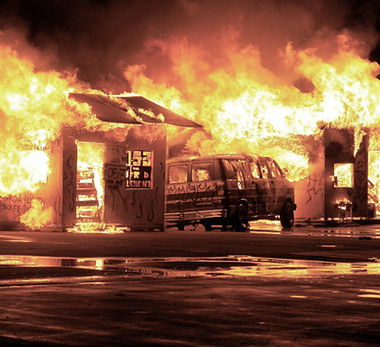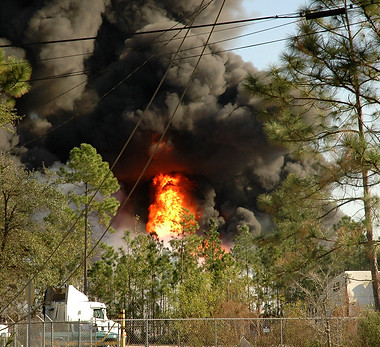
Building a Sustainable Future, in Support of Our Environment

Incidents, Which Have Devastated Country's, Communities and Businesses via Inadequate Engineering and Health & Safety Procedures and Practices.
Below, is a selection of incidents which has crippled communities, families and businesses; which has resulted in the death of thousands of people, ill-health conditions varying from minor to life changing injury's (physical, emotional and mental state).
The media below, has be taken from various sources, (Documentations, News Outlets and You-tube Channels etc. - credit to the original creators).
***Viewer Discretion is Advised***
The images and media portrays real life incidents, disasters and tragedy's, resulting in life changing injury's and death (individuals below the age of 18 years old are advised to seek parental guidance prior to viewing/ watching any / all media sources.
San Juanico Disaster 1984 (Mexico)

The San Juanico disaster was a devastating LPG (liquefied petroleum gas) explosion that occurred on November 19, 1984, at the PEMEX LPG Terminal in San Juan Ixhuatepec, Mexico City.
The explosion resulted in a major fire and series of explosions that destroyed the terminal and killed approximately 500 people. The event was caused by a combination of technical failures, inadequate safety measures, and hazardous urban planning.
Media Link: Click Here
Bhopal Disaster 1984 (India)

The Bhopal disaster, occurred in Bhopal, India on December 2-3, 1984, was a catastrophic industrial accident that resulted in the release of toxic methyl isocyanate (MIC) gas from the Union Carbide India Limited (UCIL) pesticide plant.
The leak caused thousands of deaths and injured hundreds of thousands more, with long-term health effects lasting for decades. The incident is considered one of the worst industrial disasters in history and has led to significant changes in industrial safety practices worldwide.
Media Link: Click Here
Flixborough Disaster 1974 (United Kingdom)

The Flixborough disaster was a major explosion that occurred on June 1, 1974, at the Nypro chemical plant near Flixborough, North Lincolnshire, UK.
The explosion resulted in 28 fatalities and left 36 others injured. At the time, it was Britain's largest peacetime explosion
Media Link: Click Here
Buncefield Disaster 2005 (United Kingdom)

Sunday 11 December 2005, a number of explosions occurred at Buncefield Oil Storage Depot, Hemel Hempstead, Hertfordshire. At least one of the initial explosions was of massive proportions and there was a large fire, which engulfed a high proportion of the site.
Over 40 people were injured; fortunately there were no fatalities. Significant damage occurred to both commercial and residential properties in the vicinity and a large area around the site was evacuated on emergency service advice. The fire burned for several days, destroying most of the site and emitting large clouds of black smoke into the atmosphere.
Media Link: Click Here
T2 Laboratories Disaster 2007 (Jacksonville, Florida, USA)

On December 19, 2007, four people were killed and 13 others were injured when an explosion occurred at T2 Laboratories Inc. during the production of a gasoline additive called methylcyclopentadienyl manganese tricarbonyl, which is refereed to as a runaway thermionic reaction, causing catastrophic consequences.
Media Link: Click Here
TCP Group Disaster 2019 (Port Neches, Texas, USA)

In November 2019, a series of explosions and a subsequent fire occurred at the TPC Group's Port Neches, Texas, chemical plant.
The incident caused significant property damage, impacted nearby residents, and led to evacuations. The explosions were attributed to the release of highly flammable butadiene, which formed a vapor cloud that ignited and exploded, fire continued to burn at the facility for over a month, the blast was felt upwards of 30 miles away; mandatory evacuation of 4 mile radius was imposed, Popcorn Polymer is an extremely volatile product, which grew and formed inside the process equipment/ pipework, without suitable controls, the situation become a ticking time bomb.
Media Link: Click Here
Tesoro Refinery April 2010 Disaster (Anacortes, Washington, USA)

The blast, caused when a heat exchanger ruptured after a maintenance restart, rattled every window in a two mile radius. It was Washington State's worst industrial disaster in 50 years, with 7 deaths reported.
A federal investigation found that Tesoro failed to properly test the equipment and cited a lax safety culture.
Media Link: Click Here
PCA Pulp & Paper Mill Feb 2017 Disaster (DeRidder, Louisiana, USA)
.jpg)
On February 8, 2017, a tank exploded at the Packaging Corporation of America (PCA) paper mill in DeRidder, Louisiana. The explosion killed three contractor workers and injured seven others.
The explosion occurred while the mill was undergoing a planned maintenance shutdown, and a crew was performing hot work activities on a tank containing flammable materials (flammable atmosphere within the tank itself, was neglected to be considered as part of their safe systems of work).
Media Link: Click Here
Biolab Lake Charles August 2020 Disaster (West Lake Louisiana, USA)

In August 2020, a fire and toxic gas release occurred at the Bio-Lab facility in Westlake, Louisiana, due to Hurricane Laura damage.
The hurricane caused significant structural damage to the facility, exposing chemicals to rainwater, which led to a chemical reaction, generating heat, and releasing chlorine gas. A large plume of toxic gases, including chlorine, traveled over the neighboring community, prompting a shelter-in-place order and a 28-hour closure of Interstate 10
Media Link: Click Here
The Aghorn Operating Waterflood Station October 2019 Disaster (Odessa Texas, USA)

On October 26, 2019, a hydrogen sulfide (H2S) release at the Aghorn Operating Waterflood Station in Odessa, Texas, resulted in two fatalities. The release occurred when a pump failed, leading to a release of water containing H2S, a toxic and odorless gas.
An Aghorn employee responded to an oil level alarm, and while investigating the pump house, he was overcome by the gas. Later, his wife, who had gone to the station to check on him after he didn't return home, also entered the pump house and was similarly affected. Both were found dead inside
Media Link: Click Here
Bradford City Football Club 1985 Disaster (Bradford, United Kingdom)

On 11 May 1985, 56 people were fatally injured in a devastating fire at Bradford City's Valley Parade stadium. More than 250 others were injured. Forty years on, people who were there, still share their memories of that fateful day.
The cause of the Bradford fire, was a discarded cigarette or match, and sparked what became, at the time, the worst stadium disaster in English football.
Media Link: Click Here
Kings Cross Station 1987 Disaster (London, United Kingdom)

The 1987 King's Cross station fire was a devastating incident that claimed 31 lives and injured over 100 people. The fire, sparked by a discarded lit match falling onto a wooden escalator, rapidly spread due to the "trench effect" and flashover, creating a devastating inferno.
It's believed a lit match, likely discarded by a passenger, fell through a gap on a wooden escalator and ignited grease and litter below.
Media Link: Click Here
Woolworth's May 1979 Disaster (Manchester, United Kingdom)

The Manchester Woolworths fire on May 8, 1979, resulted in the deaths of 10 people and injuries to six firefighters.
The fire, which originated in the second-floor furnishing department, was caused by a faulty electrical cable that ignited polyurethane foam furniture.
Thick, toxic smoke from the fire made it difficult to escape, leading to fatalities and injuries.
Media Link: Click Here
Woolworth's October 1973 Disaster (Colchester, United Kindom)

In October 1973, a fire at the Woolworths store on High Street in Colchester caused significant damage, destroying the entire store and its stock.
While initially thought to be a bomb explosion, the blaze was ultimately attributed to a fire, with 190 firefighters battling for 12 hours to contain it.
The fire resulted in the destruction of over £1 million worth of stock, leading to the closure of the shop. Despite a rebuilding effort, the shop ultimately closed again in 1985 due to economic troubles
Media Link: Click Here (read more here)
Grenfell June 2017 Disaster (London, United Kingdom)

On June 14, 2017, a fire broke out in Grenfell Tower, a high-rise residential building in North Kensington, London, resulting in the tragic loss of 72 lives.
The fire, originating in a fourth-floor flat from an electrical fault in a fridge-freezer, rapidly spread due to the flammable cladding installed on the building's exterior.
A public inquiry later revealed a chain of failures by various parties, including government, companies, and the fire service, contributing to the severity of the disaster
Media Link: Click Here
Inquiry Reports: Click Here
UK Power Networks 2010 - 2013 Explosions (London, United Kingdom)

The explosions in London's power network, specifically within cable pits and link boxes, are primarily caused by a build-up of gases in underground voids, often ignited by sparks from electrical faults or leaks.
While not directly caused by the UK Power Networks cabling, these explosions have led to concerns about safety and potential fatalities.
Mitigation efforts include removing or filling inactive chambers, improving ventilation, and installing restraining straps
Media Link: Click Here
Canary Wharf 2021 Fire (London, United Kingdom)

On 7th May 2021, a fire broke out at New Providence Wharf, a high-rise residential building of 19 floors.
The fire originated in a flat on the 8th floor and spread externally up the building affecting balconies directly above on the 9th, 10th and 11th floors.
The flat of origin was subsequently 80% damaged by fire. An initial investigation had identified an electrical consumer unit (commonly known as a fuse board) as
the likely cause of the fire.
Media Link: Click Here
Champlain Towers South Building Collapse June 2021 (Miami, USA)

On 24 June 2021, the Champlain Towers South building in Miami collapsed, resulting in the death of 98 people.
The condominium had substantial concrete structural damage in its pool deck area, mainly from failed waterproofing.
This damage was identified in 2018, with repairs estimated to cost USD $9 million, but they were never completed.
Before the building collapsed, inspections were mandatory 40 years after construction, and every 10 years on wards. Champlain Towers South was in its 40th year when it collapsed.
Media Link: Click Here
Issued Report: Click Here
Environmental Disasters
The Ajka Tailing Dam Failure October 2010 Disaster (Ajika, Hungray)

Around 12:30 hrs of 4th October 2010, the north-western corner of a vast reservoir containing some 30 million cubic meters of waste from an aluminum factory in the village of Ajka, in western Hungary, suddenly collapsed, giving rise to a red mud flow of nearly 1 million cubic meters, which poured out over the surrounding countryside causing an environmental catastrophe.
The village of Kolontár was struck and partly submerged by the large mass of water mixed with toxic mud from the failed reservoir, taking the inhabitants of the area by surprise. Some houses and bridges collapsed following the heavy impact of the mud flow. Eventually, an area of over 40 square kilometres was affected by the disaster.
Media Link: Click Here (read more here)
The Fundão Tailings Dam Failure November 2015 Disaster (State of Minas Gerais, Brazil)

On 5th November 2015, the Fundão tailings dam, in the State of Minas Gerais, Brazil, failed. It contained waste material from the Germano iron mine, managed by Samarco Society, a joint venture between the Anglo-Australian Bhp-Billington and the Brazilian Vale, which are two of the most important multinational mining companies worldwide.
A mudflow exceeding 30 million cubic meters struck the village of Bento Rodrigues, which was completely destroyed. In addition, the flow ran down the rivers Gualaxo do Norte, Carmel and Rio Doce for over 660 kilometres, eventually reaching the Atlantic Ocean about two weeks after failure.
There were 17 confirmed deaths, while two persons went missing. 15 square kilometres of soil were contaminated along the route of the mudflow and the supply of drinking water for 250,000 inhabitants was interrupted.
Media Link: Click Here (read more here)
The Córrego de Feijão tailings dam failure January 2019 Disaster (State of Minas Gerais, Brazil)

On 25th January 2019, at Brumadinho in the State of Minas Gerais, Brazil, a mine waste deposit, made up of several tailings dams, serving the Córrego de Feijão iron mine, collapsed and generated a huge mudflow. First, it struck the mine facilities and after a few minutes the town of Brumadinho, located some 7 km downstream. 259 people lost their lives and 11 persons went missing.
The mudflow, with a total volume of 12 million cubic metres, caused severe environmental damage and the destruction of numerous buildings and a railway bridge. There was fear that a fourth tailings dam, damaged by the mudflow, might also fail.
Media Link: Click Here (read more here)
the Jagersfontein Tailings Dam Collapse September 2022 (Jagerfontein, Free State of South Africa)

Jagersfontein is a small mining town located in the Free State of South Africa, which on Sunday the 11th September 2022 was struck by a mudflow resulting from the failure of a tailings dam. So far, the outcome of this disaster is of one life lost, one missing and 76 injured as well as 51 houses destroyed and 103 severely damaged. The mudflow ran a distance of about 9 kilometres with a front exceeding one kilometre in width.
Up to the early 1970s, at Jagersfontein there had been a diamond mine and its tailings dam had not been fed for over 50 years, although it was still used for decanting second processing tailings.
The Jagersfontein incident is disaster no. 106 after the Stava Valley catastrophe of 1985
Media Link: Click Here (read more here)
The Taoshi Tailings Fam Failure September 2008 (Linfen, in Xiangfen County, China)

On 8th September 2008, at 8:00 hrs, a mud and mine debris wiped out in just a few minutes the little mining centre of Taoshi, in the city of Linfen, in Xiangfen County, China. 128 persons were confirmed dead, but hundreds more were missing.
Bulldozers and 2,000 workers and firefighters continued to search with little hope.
The landslide pulled down a deposit of waste from the Tashan iron mine, generating an avalanche of tons of debris, stones, and mud, three storeys high and 600 metres wide. Now there are questions over why the mine waste was stored above the people’s homes, and the owner of the mine was arrested along with eight others.
Media Link: Click Here (read more here)
The Baia Mare tailings dam failure, January 2000 (Maramures District, Romania)

On 24 June 2021, the Champlain Towers South building in Miami collapsed, resulting in the death of 98 people.
The condominium had substantial concrete structural damage in its pool deck area, mainly from failed waterproofing.
This damage was identified in 2018, with repairs estimated to cost USD $9 million, but they were never completed.
Before the building collapsed, inspections were mandatory 40 years after construction, and every 10 years on wards. Champlain Towers South was in its 40th year when it collapsed.
Media Link: Click Here (read more here)
Media Clip: Click Here